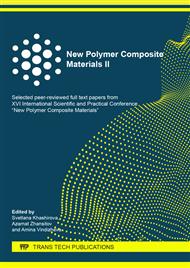[1]
E4tech, Fuel Cell Industry Review (2019).
Google Scholar
[2]
Y. Wang, D. Diaz, K. Chen, Z. Wang, X. Adroher. Materials, technological status, and fundamentals of PEM fuel cells, Materials Today. 32 (2020) 178-203.
DOI: 10.1016/j.mattod.2019.06.005
Google Scholar
[3]
S.I. Kozlov, V.N. Fateev, Fuel cells - promising chemical sources of electrical energy, Alternative fuel vehicles. 2 (2014) 7-23.
Google Scholar
[4]
Yu.A. Dobrovol'skii, E.V. Volkov, A.V. Pisareva, Yu.A. Fedotov, D.Yu Likhachev, A. L. Rusanov, Proton-Exchange Membranes for Hydrogen-Air Fuel Cells, Russian Journal of General Chemistry. 77 (2007) 766-777.
DOI: 10.1134/s1070363207040378
Google Scholar
[5]
L. Carrette, K.A. Friedric, U. Stimming, Fuel cells - fundamentals and applications, Fuel Cells. 1 (2001) 5-39.
DOI: 10.1002/1615-6854(200105)1:1<5::aid-fuce5>3.0.co;2-g
Google Scholar
[6]
A. Kraytserg, Ya. Ein-Eli, Energy & Fuels, 28 (2014) 7303-7330.
Google Scholar
[7]
F. Barbir, ed. by N, Sammes, PEM Fuel Cells, Springer London, London, (2006) 27-51.
Google Scholar
[8]
Information on http://www.solvay.com/en/markets-and-products/featured-products/ Aquivion.html.
Google Scholar
[9]
J. Li, M. Pan, H. Tang, Understanding short-side-chain perfluorinated sulfonic acid and its application for high temperature polymer electrolyte membrane fuel cells, RSC Adv. 4 (2014) 3944-3965.
DOI: 10.1039/c3ra43735c
Google Scholar
[10]
S.S. Ivanchev, M.R. Tarasevich, V.A. Bogdanovskaya, O.V. Korchagin, E.V. Burkovskii, O.N. Primachenko, V.S. Likhomanov, Performance of the Hydrogen-Air Fuel Cell with a Russian Analogue of the Aquivion Solid Polymer Electrolyte, Physical Chemestry. 464 (2015) 227-230.
DOI: 10.1134/s0012501615100012
Google Scholar
[11]
J.C. Dyre, Universality of ac conduction in disordered solids, Review of Modern Physics. 72 (2000) 873-919.
DOI: 10.1103/revmodphys.72.873
Google Scholar
[12]
V.V. Sinitsyn, A.I. Baranov, Compencation low and thermodynamics parameters of protonic conductivity in MenHm(AO4)p crystals, Ionics. 2 (1996) 478-484.
DOI: 10.1007/bf02375831
Google Scholar
[13]
C. Colosi, M. Costantini, A. Barbetta, C. Cametti, M. Dentini M., Anomalous Debye-like dielectric relaxation of water in micro-sized confined polymeric systems, Phys. Chem. Chem. Phys. 15 (2013) 20153-20160.
DOI: 10.1039/c3cp52902a
Google Scholar
[14]
M. Kinka, J. Banys, J. Macutkevic, A. Meskauskas, Conductivity of nanostructured mesoporous MCM-41 molecular sieve materials, Electrochimica Acta. 51 (2006) 6203-6206.
DOI: 10.1016/j.electacta.2006.01.069
Google Scholar
[15]
X. Ling, M. Bonn, K.F. Domke, S.H. Parekh, Correlated interfacial water transportand proton conductivity in perfluorosulfonic acid membranes, Proc. Natl. Acad. Sci. USA. 116 (2019) 8715-8720.
DOI: 10.1073/pnas.1817470116
Google Scholar
[16]
J.E. Thomaz, C.M. Lawler, M.D. Fayer, Proton Transfer in Perfluorosulfonic Acid Fuel Cell Membranes with Differing Pendant Chains and Equivalent Weights, J. Phys. Chem. B. 121 (2017) 4544-4553.
DOI: 10.1021/acs.jpcb.7b01764
Google Scholar
[17]
Fr. de los Santos, F. Giancarlo, Relations between the diffusion anomaly and cooperative rearranging regions in a hydrophobically nanoconfined water monolayer, Phys. Rev. 85 (2012) 010602-010604.
DOI: 10.1103/physreve.85.010602
Google Scholar
[18]
M.I. Ryzhkin, I.A. Ryzhkin, V.V. Sinitsyn, A.V. Klyuev, Theory of quasi-liquid surface layer, JETPh Lett. 106 (2017) 760-764.
DOI: 10.1134/s0021364017230114
Google Scholar
[19]
M.I. Ryzhkin, I.A. Ryzhkin, A.M. Kashin, E.A. Galitskaya, V.V. Sinitsyn, Proton conductivity in mesiporous materials, JETP Lett. 108 (2018) 596-600.
DOI: 10.1134/s0021364018210130
Google Scholar
[20]
M.I. Ryzhkin, A.V. Klyuev, V.V. Sinitsyn, I.A. Ryzhkin, Liquid state of hydrogen bond, JETP Lett. 104 (2016) 248-252.
DOI: 10.1134/s0021364016160013
Google Scholar
[21]
I.A. Ryzhkin, M.I. Ryzhkin, A.M. Kashin, E.A. Galitskaya, V.V. Sinitsyn, High proton conductivity state of water in nanoporous materials, Europhysics Letters. 126 (2019) 36003-36010.
DOI: 10.1209/0295-5075/126/36003
Google Scholar


